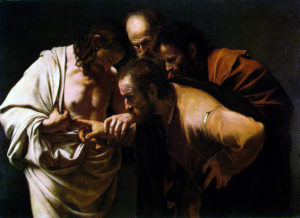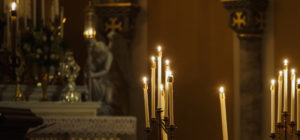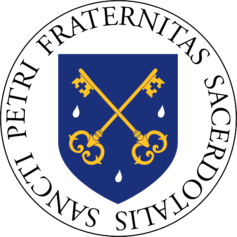The Wax, the Wick, the Flame
by Fr. William Rock, FSSP
On February 2nd, the 40th and last day of Christmas, Our Lord’s Presentation in the Temple and Our Lady’s Purification are commemorated by the Church’s Liturgy. A unique part of this day’s Liturgy is the Solemn Blessing of Candles performed before Mass. Historically, in the Roman Rite, this Blessing of Candles was one of the three Solemn Blessings given from the Epistle Corner of the Altar with the ministers vested in violet, the other two being the Solemn Blessings of the Ashes and of the Palms.
While candles have a venerable place in the Church’s liturgical life, they are also held in respect because of Whom they symbolize, namely Our Lord Jesus Christ, the “light to the revelation of the Gentiles” (Luk 2:32, from the day’s Gospel). Following the explanation of St. Anselm of Canterbury, (d. A.D. 1109) this article will examine each part of the blessed candles in turn.

According to St. Anselm, the wax of the candle represents the Flesh, the Body, of Our Lord. As the first prayer of the Solemn Blessing states, these candles are composed of “perfect wax” which was created “by the labor of bees.” Traditionally, the body, or at least the greater part of the body, of the candles used in the Mass is made of beeswax.1 This is because, in their hierarchy, the bees who produce wax are female and have a perpetual virginity. This is the nature of bees.2 There is a fittingness that female bees, possessing a perpetual virginity, should produce the wax used in the body of the candle representing Christ for out of the Blessed and Ever Virgin Mary was formed the Sacred Body of Our Lord (Gal 4:43).

Just as the faithful can touch the body of a blessed candle, so too can Our Lord’s Body be touched, for it is a true Body (1 Joh 1:1). Some heretics, called Docetists, denied that Our Lord had a real, human body, claiming that it only appeared to be so.4 Against these, St. John in his First Epistle wrote: “By this is the spirit of God known. Every spirit which confesseth that Jesus Christ is come in the flesh is of God: And every spirit that dissolveth Jesus,” that is, anyone who denies the reality of the Our Lord’s Body, “is not of God. And this is Antichrist, of whom you have heard that he cometh: and he is now already in the world” (4:2-3). In his Second Epistle, St. John warns that “many seducers are gone out into the world who confess not that Jesus Christ is come in the flesh” (1:7).

Turning to the wick, St. Anselm sees symbolized the soul of Our Lord. The soul makes the material component of the human person a human body. The wick makes a candle, a candle, and not just a collection of wax. But there were heretics, such as Arius, who denied that Our Lord has a human soul, claiming the Divine Nature took the place of Our Lord’s human soul. The position that Our Lord did not have a human, rational soul was condemned by the Council of Chalcedon (A.D. 451), the Second Council of Constantinople (A.D. 553), and the Council of Vienne (A.D. 1311–1312), all Ecumenical Councils. As the Athanasian Creed (Symbolum Quicumque) states, Our Lord is “perfect God and perfect man, subsisting with a rational soul and human flesh.”5
In the flame, St. Anselm understands Our Lord’s Divinity, for, as St. Paul wrote in the Letter to the Hebrews, quoting Deuteronomy, “our God is a consuming fire” (Heb 12:29/Deu 4:24). As St. Thomas explains in his commentary on this passage, God is not really a fire, for He is a spirit (Joh 4:24). But God is compared to fire
on account of His clarity, because He inhabits light inaccessible (1 Tim 6:16), and because He is supremely active: you have worked all our works in us (Isa 26:12), and He is in a loftier place: the Lord is high above all nations; and His glory above the heavens (Ps 113:4). Furthermore, He cleanses, and as it were, consumes sins; hence, He says that He is a consuming fire: He is like a refining fire, and what follows, and He shall purify the sons of Levi (Mal 3:2, 3); making purgation of sins (Heb 1:3). He also consumes sinners by punishing: but a certain dreadful expectation of judgment, and the rage of a fire which shall consume the adversaries (Heb 10:27).
Therefore, because such things are promised to us: and the light of Israel shall be as a fire, and the holy one thereof as a flame (Isa 10:17); a fire shall go before them and shall burn up enemies round about (Ps 97:3), we should strive to serve and please God.6

It should be noted that in his explanation of why God is likened to a consuming fire, St. Thomas quotes from the third chapter of the Book of the Prophet Malachias. The first four verses of this chapter, which includes the text quoted by St. Thomas, are used by the Roman Church as the Epistle for the Feast of the Purification.
It is in this manner that St. Anselm invites us to see Our Lord symbolized in blessed candles: “The wax, he says, which is the product of the virginal bee, is the Flesh of our Lord; the wick, which is within, is his Soul; the flame, which burns on the top, is his Divinity.”7
William Rock, FSSP was ordained in the fall of 2019 and is currently assigned to Regina Caeli Parish in Houston, TX.
- See Matters Liturgical [1959], 154.
- About Honey Bees – Types, Races, and Anatomy from the University of Arkansas System, Division of Agricultural.
- Ott, Ludwig, Fundamentals of Catholic Dogma. Baronius Press, 2018, p. 155.
- Ibid., p. 152.
- Ibid., pp. 153-154.
- St. Thomas Aquinas’ Commentary on Hebrews, 725.
- Prosper, Guéranger. The Liturgical Year – Volume III – Christmas, Book II. Fitzwilliam: Loreto Publications, 2000, p. 474.
February 8, 2022









